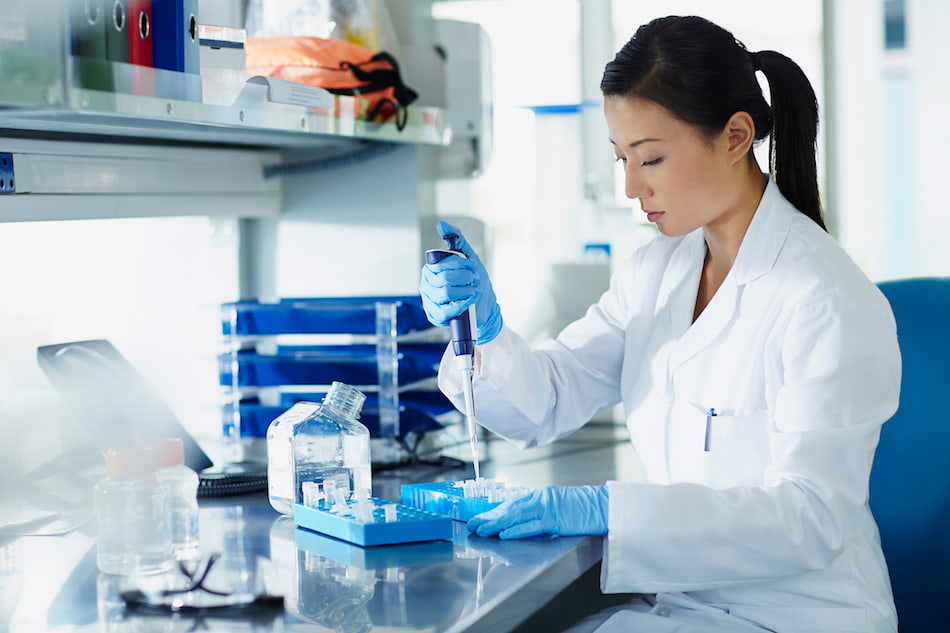Modern biotechnology focuses primarily on medicine. In this field, small startups, multinational pharmaceutical companies, and government research agencies develop new treatment options for rare and complex diseases, as well as genetic tests to better identify inherited diseases. Other fields of biotechnology include agriculture, alternative energy, and environmental science.
Students who graduate with a master’s degree in biotechnology move on to a wide range of careers in biotech, such as biomedical engineering, clinical technology, microbiology, biomanufacturing, epidemiology, and genetic counseling. These careers offer a wide range of salaries, according to the Bureau of Labor Statistics—from $76,000 for microbiologists to over $95,000 for biochemists—along with faster-than-average projections for job growth.
Whether you are new to the field of biotech or looking to expand your current role, these six emerging trends in biotechnology should help guide your job search and professional development opportunities.
Download Our Free Guide to Advancing Your Biotechnology Career
Learn how to transform your career in an industry that’s transforming the world.
Top Biotechnology Trends
1. The Use of Next-Generation Computing Technology
Technology has always been at the heart of biotech. The emergence of advanced computing technology such as machine learning and artificial intelligence enables companies to expand the scope and scale of their research and improve efficiency in the manufacturing process—both of which reduce the time it takes for biotech firms to bring new products to market.
In medicine, for example, the ability to analyze large data sets helps drugmakers identify treatments based on the cause of a disease. This has the potential to reduce the $2.6 billion price tag and the 90 percent failure rate for developing new drugs.
In addition, the evolution of cloud computing technology has removed a barrier for many innovations in biotech. The ability to run applications through the cloud allows companies to store and analyze data without buying expensive computer hardware. This benefits early-stage startups, which try to limit operating expenses as much as possible, but it also helps larger and more established companies, as it makes it easier and cheaper to allocate resources for new projects.
2. Increased Stakeholder Collaboration
Another benefit of cloud computing is its ability to support collaboration among stakeholders that represent different organizations, whether it’s multinational firms, smaller companies, academic institutions, or government research organizations. Software tools that support communication, data sharing, and virtual meetings enable groups to work together regardless of where they are located—opening the research process to a much larger group of stakeholders.
Increased collaboration does pose a potential challenge to biotechnology professionals. With larger teams working on projects, and with some projects taking many years to receive regulatory approval or achieve a return on investment, individuals and the organizations they represent need to consider intellectual property protection for the innovations they are developing. Otherwise, they may not financially benefit from the products they create.
3. The Evolution of Clinical Trials
A range of technological advances has transformed the clinical trial process. Clinical trials used to be a very manual process, with trial participants going to a clinic in-person to receive treatment and recording their symptoms and side effects on paper. In addition, drugmakers typically needed to recruit a large number of participants in order to get the right sample size—or they needed to invest heavily in marketing resources to recruit the right patients to treat a rare condition.
Today, the clinical trial has been heavily digitized, enabling biotech companies to test treatments on more patients in less time. In a notable example, in November 2019 the medical genetics company known as Invitae announced a trial with Apple Watch that brings together biometric data collected from the wristwatch and the results of genetic tests in an effort to determine the genes that cause cardiovascular disease. This makes the trial accessible to a larger number of people, and it helps researchers quickly exclude patients who do not meet the criteria for the trial.
As noted, machine learning technology also holds promise for the future of the clinical trial. Biotech companies can quickly analyze data from current trials to predict the effectiveness of treatments down to a molecular level; they can also revisit data from previous trials to see if anything may have been missed, or if there may be new or different uses for an existing drug.
4. Growth in Personalized Treatment of Rare Diseases
The reduced cost of genetic sequencing—from $2.7 billion for the Human Genome Project in 1990 to less than $300 today, and potentially less than $100 in the near future—allows for much more extensive screening of trial participants and targeting of interventions. This has enabled the development of personalized treatment plans and targeted therapies, which are more effective than less-specific therapies because they focus on a patient’s genetic and molecular makeup.
Cancer treatment is a key area of focus for targeted therapies. One prominent example is blood cancer such as leukemia, where a treatment called CAR T-cell therapy targets a patient’s immune cells and, in the words of the National Cancer Institute, the immune system will “attack tumors.”
5. Demand for Higher Agricultural Yields
According to the United Nations, the global population is set to increase by more than 25 percent in the next 30 years, from 7.7 billion in 2019 to 9.7 billion in 2050. A growing population leads to a higher demand for food, both for people and for livestock, and it also puts pressure on the use of land as urban areas expand onto lands used for farming.
These global trends provide opportunities for biotechnology to improve agricultural yields. Gene editing, for example, could produce varieties of wheat or corn that can grow in harsher conditions or produce more grain in a smaller area than other crop varieties while providing the same nutritional value. In addition, the development of biological pesticides has the potential to protect crops without the use of harmful chemicals or environmental damage.
6. The Emergence of Value-Based Pricing Models
Under value-based pricing agreements, a buyer and a seller link payments to a specific value achieved as opposed to a volume of sales. These agreements are meant to align the incentives between the manufacturers and purchasers of a product—they often require a different pricing model than traditional contracts, and they require clear language to explain terms and conditions.
Value-based contracts recognize that both parties are taking a financial risk in the use of a new product. In healthcare, for example, a value-based pricing model might stipulate that a drug maker receives a lower payment unless a medication achieves measurable improvements when compared to other treatment options. In environmental science, value-based pricing could be targeted to the percent of waste cleaned through the use of microorganisms.
7. The Rise in Monoclonal Antibodies and Biosimilars
Monoclonal antibodies are lab-grown antibodies designed to restore, enhance, or mimic an immune system response, particularly in cancer cells. They function in a variety of ways, from identifying cancer cells to delivering radiation to affected areas. While these antibodies have formed the basis of biotechnology for some time, they are now being modified in new ways.
Biosimilars, another foundational element of biotech, have also been modified to meet changing medical needs. Creating a biological drug, which uses living organisms as ingredients, with the exact same makeup and effects as another biological drug is a complex process. Biosimilars deliver the same effects as an existing drug but use slightly different compositions than name brands, making immunotherapy and targeted therapy drugs more accessible. Generic drugs, though comparable, have the exact same composition as an existing, synthetic-based medication.
8. The Advancement of Cell and Gene Therapies
Cell and gene therapies, which manipulate human cells and genomes, respectively, to create customized drugs, are booming areas of biotechnology.
“A large portion of this industry is going towards personalized medicine,” Auclair says.
The FDA approved the first-ever gene therapy, a drug called Kymriah, in 2017. The medication uses a patient’s own white blood cells to treat acute lymphatic leukemia. Yescarta, another gene therapy approved in the same year, has provided at least partial remission for 72 percent of patients with non-Hodgkin’s lymphoma in clinical trials.
Since then, this area of biotechnology has doubled in growth. Experts predict a steady pace going forward as more companies move into late-stage manufacturing after promising outcomes in oncology, regenerative medicine, and rare diseases. Despite challenges related to capacity and the ability to scale production, FDA commissioner Scott Gottlieb expects the agency to confer 10 to 20 gene- and cell-therapy related approvals each year through 2025 as biotech continues to fast-track new projects.
9. Vaccine Development
The search for preventing the spread of the COVID-19 virus has forced the scientific community to consider new ways of developing vaccines. Government agencies and biopharmaceutical companies have entered into unprecedented public-private partnerships to fund research and pool resources in this area, furthering our understanding of vaccines as a whole in the process.
“The traditional vaccines that are on the market are based on similar science and similar technologies,” Auclair says. “What kind of new vaccines can we develop that are not based on attenuated viruses or other things we’ve done in the past? How does that go?”
The research and development process behind this vaccine, and other COVID-related vaccines, can provide valuable information about how to create more effective preventative measures in the future
Advancing in the Biotechnology Industry
These trends in biotechnology show that today’s biotech professionals need more than just a background in biology, chemistry, or pharmaceutical science to advance their careers. Business skills are critical for managing a research project or technical team, while technology expertise can add real-time analysis to cutting-edge research and development.
A Master of Science in Biotechnology from Northeastern combines an interdisciplinary and hands-on science curriculum with real-world work experience with leading industry, academic, and government employers. Concentrations include pharmaceutical technology, scientific information management, and manufacturing and quality operations.
Download our free guide below to learn more about advancing your biotech career.







Related Articles
Compliance Specialists: Who They Are and What They Earn
Science or Science Fiction? The Future of Personalized Medicine
In-Demand Biotechnology Careers Shaping Our Future